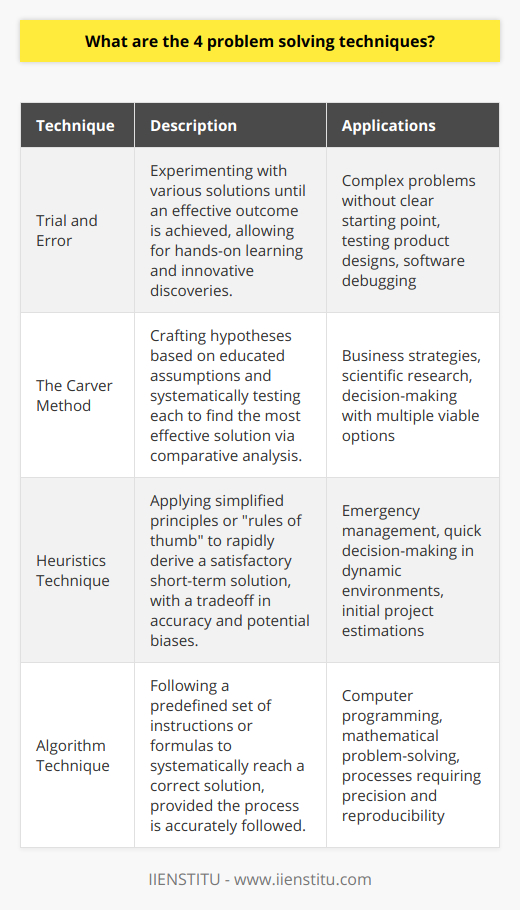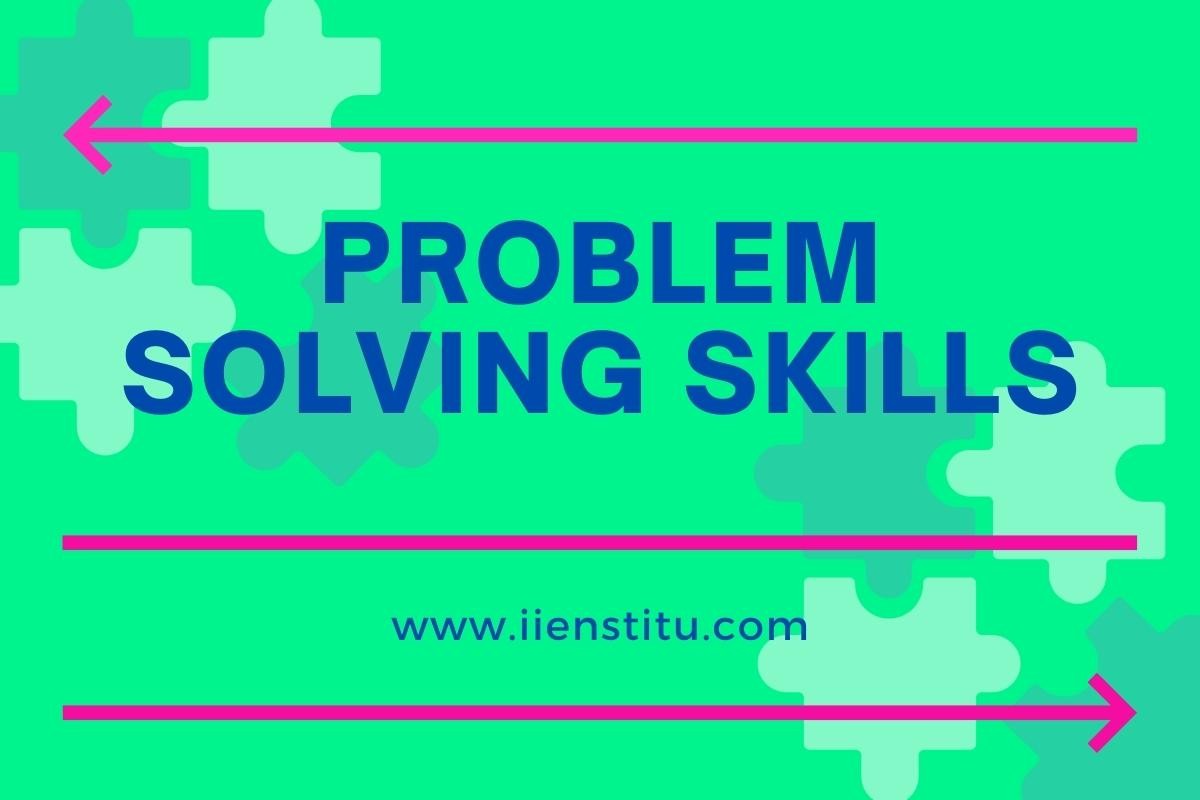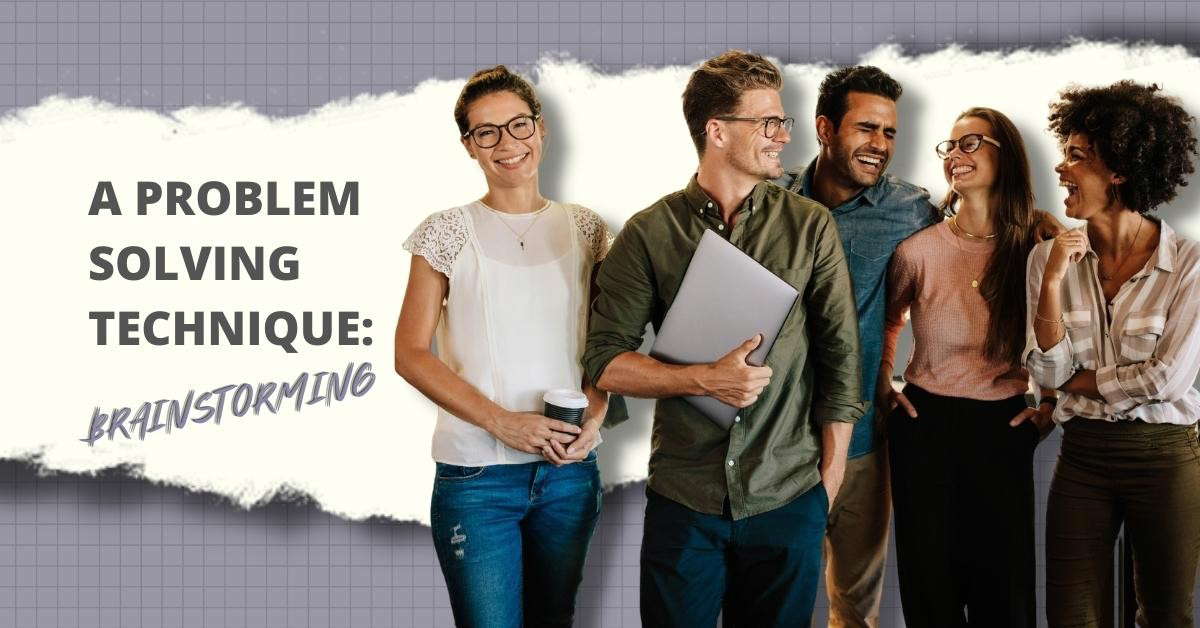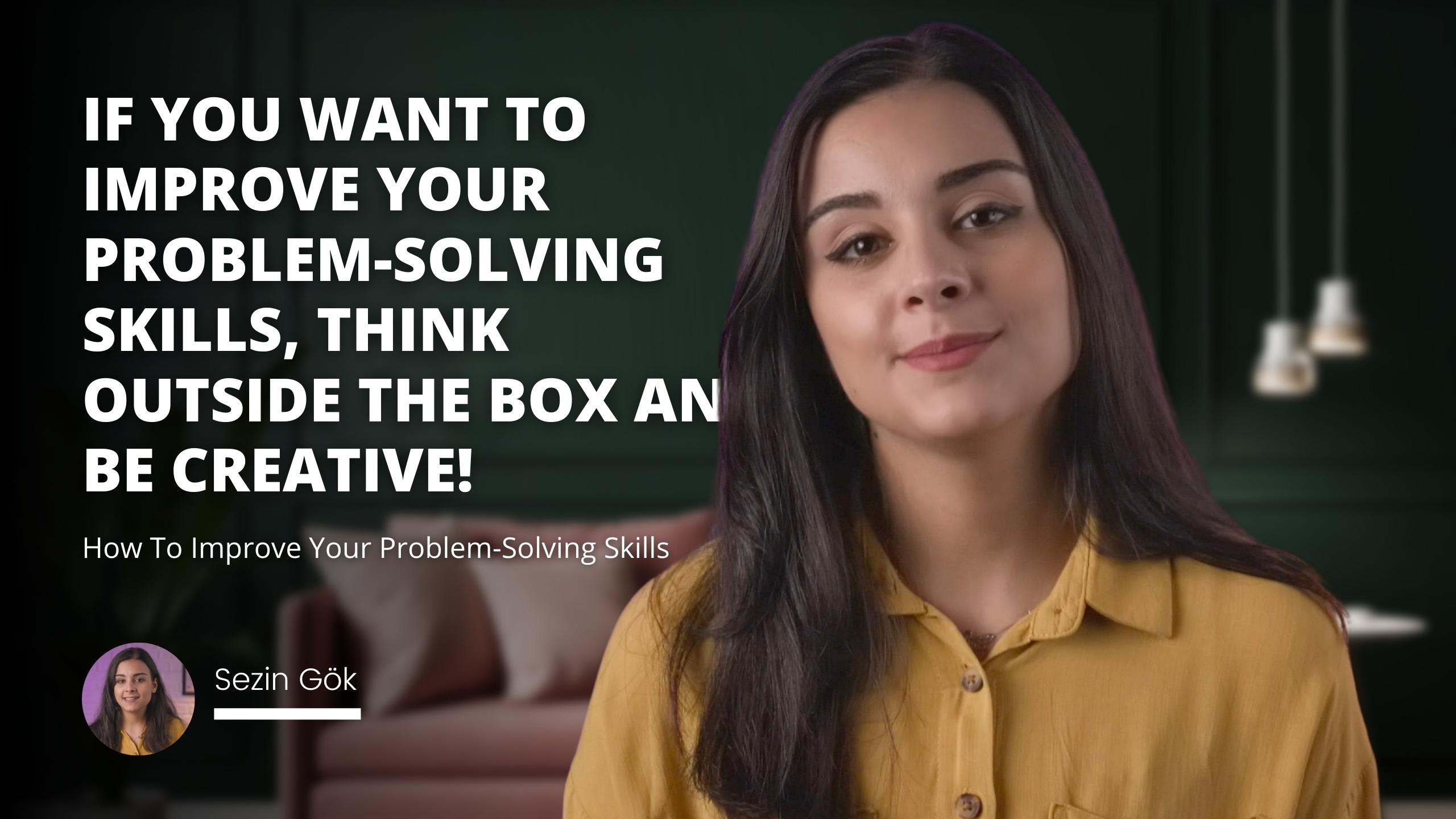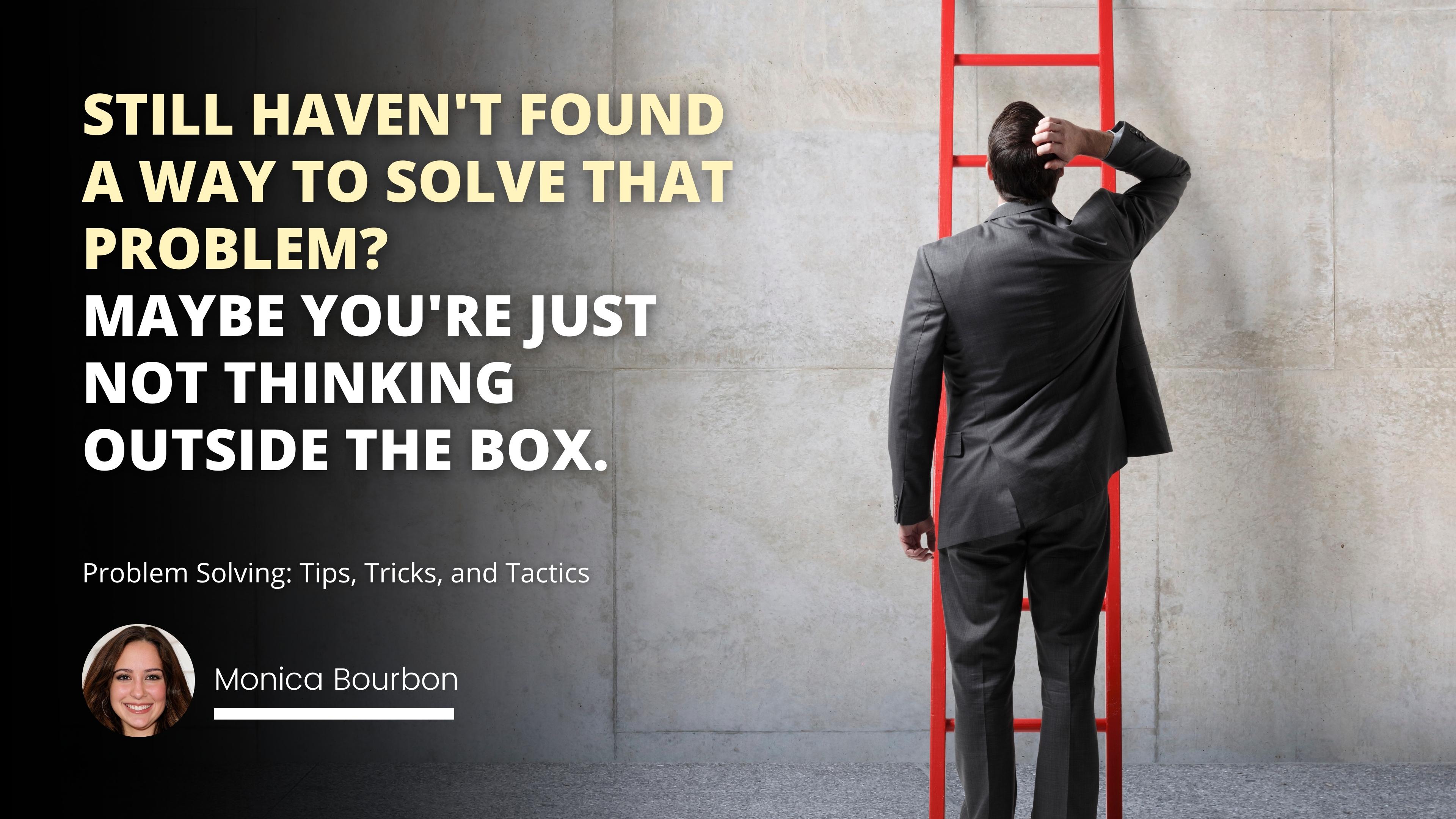
It's often said that life is a series of problems waiting to be solved. Whether it's figuring out how to navigate a new city, tackling a challenging project at work, or simply deciding what's for dinner, our ability to solve problems defines much of our daily experience. Over the years, I've found that having a toolbox of skills and tactics can make all the difference in not just overcoming obstacles but thriving in the face of them.
Let's dive into some tips, tricks, and tactics that can help you become a more effective problem solver. Along the way, I'll share some personal stories and insights that have shaped my own approach to tackling challenges.
Taking a Step Back: The Power of Pause
A few years ago, I was working on a critical project with a tight deadline. We were using the critical path method project management strategy to ensure we stayed on track. One afternoon, we hit a major roadblock that threatened to derail the entire project. My first instinct was to scramble for a quick fix, but instead, I decided to take a step back and assess the situation.
I remember thinking, "Maybe rushing isn't the answer here." So, I gathered the team, and we took the time to thoroughly understand the problem. By doing so, we discovered that the issue wasn't as severe as we initially thought. In fact, it opened up an opportunity to improve our process. This experience taught me the value of pausing before acting.
Why Pausing Matters
Clarity: Stepping back allows you to see the problem more clearly.
Perspective: It helps you consider different angles and viewpoints.
Calmness: It reduces the stress and urgency that can cloud judgment.
Preparation: Gives you time to gather resources and information.
Prevention: Avoids potential mistakes from hasty decisions.
In the words of psychologist Daniel Kahneman, "We are prone to overreact to threats and underestimate opportunities."^[Kahneman, D. (2011). Thinking, Fast and Slow. Farrar, Straus and Giroux.]
Brainstorming: Embracing Creativity
Once you've taken the time to understand the problem, the next step is to brainstorm possible solutions. I can't tell you how many times I've been in meetings where someone says, "We've tried everything," only to find out they've only considered a few options.
A technique I've found incredibly helpful is mind mapping. By visually laying out ideas, you can see connections you might have missed otherwise. For example, when I was trying to increase user engagement on a website, a mind map helped me link user feedback to design changes we hadn't considered.
Considering All Angles
Different Perspectives: Invite input from others to gain new insights.
Think Outside the Box: Don't dismiss ideas that seem unconventional.
List All Options: Write down every idea, no matter how small.
Ask "What If?": Challenge existing assumptions.
Use Analogies: Relate the problem to something familiar.
According to Edward de Bono, "Creativity involves breaking out of established patterns in order to look at things in a different way."^[De Bono, E. (1990). Lateral Thinking for Management. Penguin Books.]
Choosing and Implementing the Best Solution
After generating a list of potential solutions, it's time to choose the best one and implement it as quickly as possible. I recall a time when I was leading a team that had to cut costs without sacrificing quality. We had brainstormed several options, but we needed to act swiftly.
We evaluated each option based on impact and feasibility. In the end, we decided to renegotiate with our suppliers, which resulted in immediate savings. Acting quickly prevented further financial strain.
Action Steps
1- Evaluate Options: Consider the pros and cons.
2- Prioritize Solutions: Rank them based on effectiveness.
3- Make a Decision: Choose the solution that offers the best balance.
4- Develop a Plan: Outline the steps needed for implementation.
5- Implement Swiftly: Don't let indecision slow you down.
As Peter Drucker aptly puts it, "Unless commitment is made, there are only promises and hopes... but no plans."^[Drucker, P. F. (1954). The Practice of Management. Harper & Row.]
Evaluating Results and Adjusting
Implementing a solution isn't the final step. It's crucial to evaluate the results and make any necessary adjustments. When we renegotiated with our suppliers, we saved money, but we also noticed a slight drop in product quality. This feedback prompted us to adjust our approach, finding a balance between cost and quality.
Continuous Improvement
Monitor Outcomes: Keep track of the results of your actions.
Gather Feedback: Listen to stakeholders and team members.
Be Flexible: Don't hesitate to make changes if needed.
Document Lessons Learned: This helps in future problem-solving.
Celebrate Small Wins: Acknowledge progress to stay motivated.
The concept of continuous improvement is central to methodologies like Kaizen, which emphasizes that small, ongoing positive changes can reap significant improvements.^[Imai, M. (1986). Kaizen: The Key to Japan's Competitive Success. McGraw-Hill.]

Repeating the Process
Problem-solving is not a one-time event; it's an ongoing process. Life will always throw new challenges our way. By repeating these steps—pausing, brainstorming, implementing, and evaluating—we build resilience and adaptability.
Building Habits
Practice Regularly: The more you use these steps, the more intuitive they become.
Stay Curious: Always look for better ways to do things.
Embrace Challenges: See problems as opportunities rather than obstacles.
Learn Continuously: Keep updating your knowledge and skills.
Network: Engage with others to exchange ideas and strategies.
Psychologist Carol Dweck's research on the growth mindset highlights the importance of viewing challenges as opportunities to grow.^[Dweck, C. S. (2006). Mindset: The New Psychology of Success. Random House.]
Celebrating Successes
Finally, it's essential to celebrate your successes, no matter how small. I remember the first time I solved a complex problem on my own; it was a small victory, but it boosted my confidence immensely. Recognizing your achievements keeps you motivated and reinforces positive behavior.
Ways to Celebrate
Share with Others: Tell friends or colleagues about your success.
Reflect on Your Journey: Take a moment to appreciate how far you've come.
Reward Yourself: Treat yourself to something you enjoy.
Set New Goals: Use success as a springboard for future objectives.
Express Gratitude: Thank those who helped along the way.
In the words of William James, "The deepest principle in human nature is the craving to be appreciated."^[James, W. (1892). Psychology: The Briefer Course. Henry Holt and Company.]
Bringing It All Together
Throughout my journey, embracing these problem-solving tactics has not only made me more effective but also enriched my life in unexpected ways. It's amazing how a structured approach can transform daunting challenges into manageable tasks.
One of the most profound experiences I had was volunteering abroad. Faced with language barriers and limited resources, applying these problem-solving steps was crucial. Taking a step back, I assessed the needs of the community. Brainstorming with locals, we came up with sustainable solutions. Implementing these ideas and evaluating the outcomes led to significant improvements in education and health services.
Final Thoughts
Becoming an effective problem solver is a journey, not a destination. By incorporating these strategies into your daily life, you'll find that challenges become less daunting and more manageable. Remember to take a step back, brainstorm creatively, act decisively, evaluate critically, and celebrate your progress.
I've found that these approaches not only help in professional settings but also enrich personal life. Whether you're dealing with a complex project or deciding on your next vacation spot, effective problem-solving skills make all the difference.
Next Steps
If you're interested in developing these skills further, I invite you to join us for our upcoming Problem-Solving Mastery Course. This four-day course is designed to equip you with advanced techniques and practical tools to tackle any challenge that comes your way. Together, we'll dive deeper into:
Brainstorming Techniques: Learn methods like SCAMPER and Six Thinking Hats.
Logical Thinking Processes: Enhance your reasoning and analytical skills.
Decision-Making Models: Understand frameworks to make better choices.
Creative Problem-Solving: Unlock innovative solutions.
Overcoming Psychological Barriers: Tackle procrastination and fear of failure.
Sign up today and take the first step towards becoming a problem-solving pro!
References
1- Kahneman, D. (2011). Thinking, Fast and Slow. Farrar, Straus and Giroux.
2- De Bono, E. (1990). Lateral Thinking for Management. Penguin Books.
3- Drucker, P. F. (1954). The Practice of Management. Harper & Row.
4- Imai, M. (1986). Kaizen: The Key to Japan's Competitive Success. McGraw-Hill.
5- Dweck, C. S. (2006). Mindset: The New Psychology of Success. Random House.
6- James, W. (1892). Psychology: The Briefer Course. Henry Holt and Company.
Remember, every problem is an opportunity in disguise. Embrace the journey, and you'll not only solve problems but also unlock new possibilities in your personal and professional life.
Frequently Asked Questions
What are your top tips for solving problems?
When it comes to problem-solving, there are a few key things to keep in mind. First and foremost, try to remain calm and focused. It can be easy to get caught up in the emotions of a situation, but it’s important to remember that this will only hamper your ability to think clearly and come up with a solution. Secondly, it’s essential to think outside the box. Don’t be afraid to explore different options and think creatively about how to approach the problem. And finally, don’t hesitate to ask for help if you need it. Whether it’s asking a friend for their opinion or consulting with an expert, getting another perspective can often be invaluable in finding.
What do you think are the best tactics for problem-solving?
There's no one answer to this question, as the best tactics for problem-solving vary depending on the situation. However, a few general principles can help you become better at solving problems.
First, it's essential to have a good understanding of the problem you're trying to solve. Then, identify all the factors contributing to the problem, and make sure you have a clear picture of what needs to be done to fix it. Once you understand the problem well, you can start brainstorming potential solutions.
It can also be helpful to take a step back and look at the situation from different angles.
Do you have any tricks for problem-solving that you’ve found to be helpful?
Yes, I certainly do. One of the things that have been most helpful for me is to break a problem down into smaller chunks and then work on each piece individually. This helps to prevent feeling overwhelmed and allows me to focus on one specific task at a time.
Another thing that has been useful for me is to come up with a plan of action before beginning to work on a problem. This plan can be as simple as writing down the steps I will take to solve the problem or drawing a diagram of the situation. Having a plan helps me stay organized and focused while working on the issue.
Finally, I often find it helpful to discuss the problem with someone else.
What are the essential elements of effective problem-solving techniques?
Essential Elements of Effective Problem-Solving Techniques
Understanding the Problem
The first essential element of effective problem-solving is to clearly understand the problem at hand. This requires critically analyzing the situation, identifying the underlying issues, and defining the problem statement accurately.
Identifying Objectives
Effective problem-solving also necessitates the identification of objectives or goals. Establishing clear and realistic objectives helps in forming the basis for designing potential solutions and evaluating their effectiveness later.
Gathering Information
In order to solve a problem effectively, all relevant information must be gathered and evaluated. This includes identifying possible sources, collecting essential data through research or personal investigation, and organizing the information for a thorough analysis.
Generating Possible Solutions
An indispensable element of effective problem-solving is the generation of multiple possible solutions. This step involves brainstorming, using creativity, and considering various perspectives to explore and list all potential options to address the problem.
Evaluating Potential Solutions
After generating potential solutions, it is crucial to assess the viability and effectiveness of each option. This evaluation process should consider the possible outcomes, costs and benefits, feasibility, and alignment with the identified objectives.
Implementing the Chosen Solution
Once the best solution has been identified, effective problem-solving requires implementing the chosen option. This entails taking the necessary steps to put the solution into action and addressing any barriers or resistance that may arise during implementation.
Monitoring and Review
Finally, an essential element of problem-solving is monitoring the implemented solution and reviewing its effectiveness. This includes gathering feedback and analyzing results to assess whether the solution has addressed the problem successfully or if additional adjustments are needed. This iterative process is crucial for ongoing improvement and refinement of problem-solving techniques.
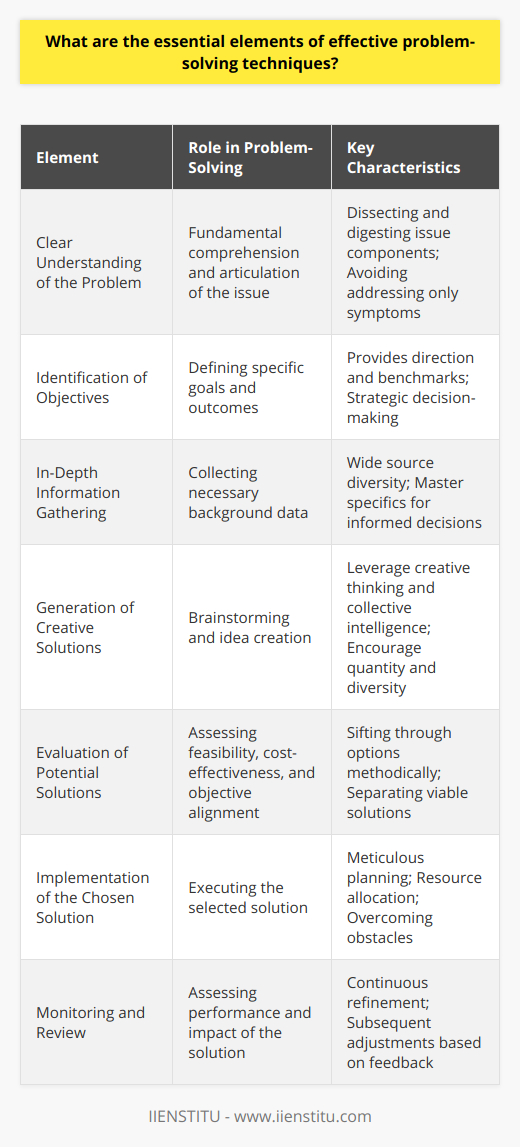
In which situations might the various problem-solving strategies be most applicable?
Situations for Analytical Problem-Solving
Analytical problem-solving strategies are often most effective when facing well-structured problems that involve measurable and quantifiable variables. For example, these strategies work well in complex situations with multiple components, where the problem-solver systematically breaks down the problem into smaller, manageable parts. This approach is particularly useful in technical fields such as mathematics, engineering, and computing.
Creative Problem-Solving and its Applications
In contrast, creative problem-solving strategies are best suited to ill-structured, ambiguous, or novel situations that require unconventional thinking. These strategies typically involve brainstorming, metaphorical thinking, or engaging in lateral thinking activities to explore a variety of potential solutions. Creative problem-solving is particularly relevant in fields such as art, design, marketing, and social sciences, or whenever innovative solutions are needed.
Applicability of Heuristic Methods
Heuristic problem-solving methods involve the use of mental shortcuts, rules of thumb, or simple guiding principles to find approximate solutions or quickly make decisions. Heuristics are most applicable in real-world situations where time constraints or limited resources prevent deep analyses or exhaustive searches for solutions. These methods are useful in fast-paced, dynamic environments, such as making decisions in business, sports, or emergency situations.
Integrating Collaborative Strategies
Collaborative problem-solving strategies are most effective when several individuals bring diverse perspectives, expertise, or skills to address a shared problem. This approach can be utilized in interdisciplinary projects, complex organizational settings, or when solutions require collective action or consensus-building. Collaborative strategies often lead to innovative or synergistic results, as the combined efforts of the group can be greater than the sum of its parts.
Selecting Appropriate Strategies
Ultimately, choosing the most applicable problem-solving strategy requires careful consideration of the problem at hand, as well as the context, domain, and constraints surrounding it. Recognizing the nature of the problem, the resources available to address it, and the intended goals or outcomes can help guide the selection of strategies most likely to generate effective, efficient, and satisfactory solutions.
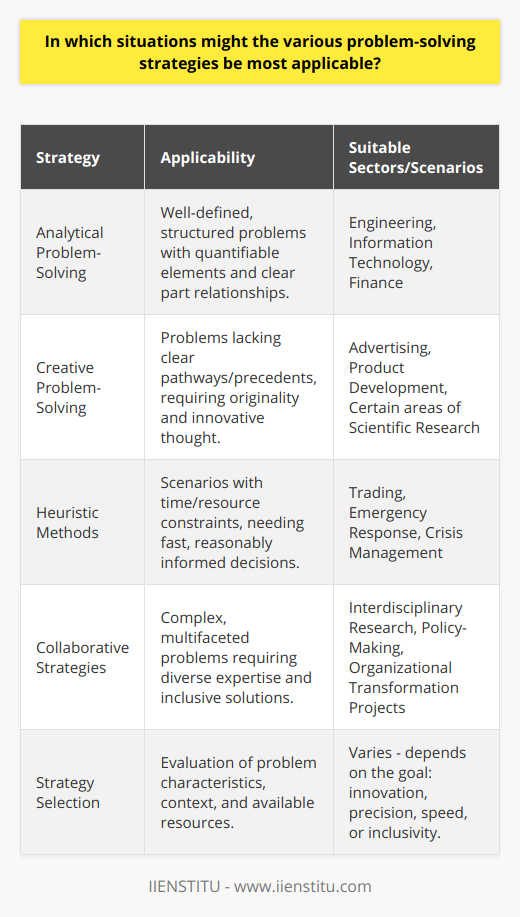
How can one cultivate a problem-solving mindset in personal and professional life?
Develop a Growth Mindset
To cultivate a problem-solving mindset in personal and professional life, one must first develop a growth mindset. A growth mindset is the belief that skills and abilities can be acquired and developed through hard work, commitment, and feedback. By embracing challenges and viewing failures as opportunities to learn, individuals with a growth mindset are better equipped to approach problems with confidence and creativity.
Practice Problem-Solving Techniques
To hone problem-solving skills, practice various problem-solving techniques, such as brainstorming, root cause analysis, and the five whys. Develop an analytical approach to breaking down problems into smaller, manageable parts. By practicing these techniques regularly, one can become more proficient and adept at tackling problems in various situations.
Seek Diverse Perspectives
In order to cultivate a problem-solving mindset, it's important to seek diverse perspectives and interdisciplinary approaches. Collaborating with others who have different backgrounds, skills, and experiences allows for the creation of innovative solutions that might not be achieved individually. Consult with experts, attend workshops, and network with professionals from various fields to gain new perspectives on problem-solving.
Embrace Change and Adaptability
In both personal and professional life, change is inevitable. By embracing change and viewing it as an opportunity for growth, one can develop a mindset geared towards tackling problems and finding effective solutions. This includes remaining adaptable and open-minded, recognizing that the best solutions may change over time as new information and insights become available.
Learn from Past Experiences
Reflect on past experiences, both successes, and failures, to draw valuable lessons that can inform future problem-solving approaches. By critically assessing previous experiences and identifying areas for improvement, one can better understand their problem-solving strengths and weaknesses. Furthermore, reflecting on past experiences can also serve as motivation to continue learning and developing effective problem-solving strategies.
In summary, cultivating a problem-solving mindset in personal and professional life involves developing a growth mindset, practicing problem-solving techniques, seeking diverse perspectives, embracing change and adaptability, and learning from past experiences. By incorporating these practices into daily life, individuals can become more proficient at effectively addressing and overcoming challenges they may face.
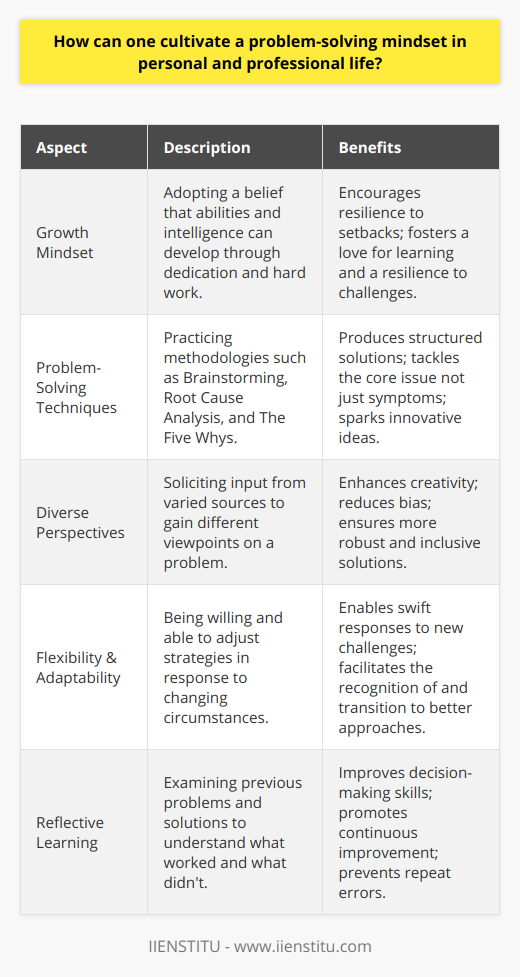
What are the 5 problem solving techniques?
Problem-Solving Techniques Explained
There exist several problem-solving techniques that can empower individuals to handle complex issues. The following five count among the most effective.
Brainstorming
Brainstorming encourages individuals or groups to generate ideas or solutions without judgment. This technique typically fosters creativity and innovation, making it suitable for complex, less defined problems.
Root cause analysis
This technique involves investigating and identifying the underlying cause of a problem. Knowing the exact source of a problem facilitates the development of sustainable solutions since it promotes addressing the problem from its origin.
The Five Whys technique
The Five Whys Technique constitutes a means by which you can dive deeper into a problem by asking 'why' five times. This approach makes it easier to understand the problem's essence and develop fitting solutions.
Decision matrix analysis
Making decisions may prove difficult when multiple proposals present themselves. A decision matrix analysis aids in evaluating various potential solutions to choose the most effective one. The decision matrix is useful for comparing and ranking different solutions based on assigned weights or scores.
Mind maps
Mind maps provide a visual overview of a problem and its potential solutions. By illustrating a problem's various aspects and potential outcomes, this technique assists in creating a comprehensive understanding of all encompassing factors.
These techniques are not mutually exclusive and often may be used collectively, in tandem, to solve complex problems.

What are the 7 problem solving techniques?
Problem Solving Techniques
The first problem-solving technique is Brainstorming. This team-based technique encourages creativity and generates a slew of solutions. Participants should feel comfortable to share their ideas without judgment.
Second is Root Cause Analysis. This method dives deep into a problem to identify its root cause. By resolving the root cause, one can prevent similar issues from reoccurring.
Third is the 5 Whys Technique. This model helps identify the root cause by asking 'why?' until reaching the core of the problem.
The fourth technique is the Fishbone Diagram, also known as Cause and Effect Diagram. It categorizes the potential causes of a problem, facilitating a structural analysis.
Next is the PDCA (Plan, Do, Check, Act) Cycle. A structured method for continual improvement, PDCA rotates in repeating cycles to ensure constant progress.
The sixth technique is SWOT Analysis. It assesses the Strengths, Weaknesses, Opportunities and Threats in a situation, allowing for strategic planning.
Finally, the 7th technique is the Flowchart method. It demonstrates a step-by-step process, depicting tasks, decision points and outcomes, offering a graphical representation of the problem.
Collectively, these seven powerful techniques provide a varied toolkit for tackling challenging problems. By mastering these methods, one can significantly enhance their problem-solving capabilities.
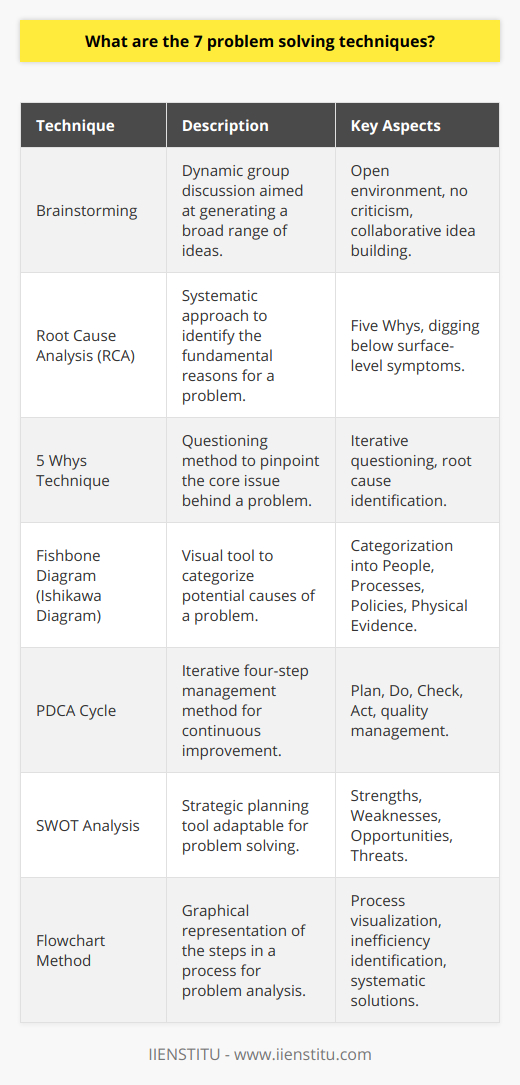
What are the 4 problem solving techniques?
Four problem-solving techniques exist that can help analyze and resolve different scenarios.
Trial and Error
Trial and error, the simplest of all, involves attempting various solutions until finding one that works. While it may seem haphazard, it is actually a highly pragmatic technique: actions taken often produce faster results than merely theorizing.
The Carver Method
An educated guess and check, known as the Carver Method, is a more sophisticated approach. This technique involves forming assumptions about potential solutions and testing their validity. It is especially effective when several possible resolutions exist.
Heuristics Technique
The heuristics technique is a shortcut method usually used as a temporary solution when time is the essence. The primary aim here isn't to identify the perfect solution but rather to deliver a quick answer that suffices under the circumstances. It is beneficial in situations where an immediate reaction is necessary, although it might not provide the most thorough solution.
Algorithm Technique
Lastly, the algorithm technique is a step-by-step set approach to problem-solving that guarantees a solution if done correctly. However, it can be time-consuming, and its practicality depends on the complexity of the problem.
Effectively applying these four problem-solving techniques requires an understanding of the issue at hand and the context in which it has occurred. By choosing the right approach, it becomes significantly easier to tackle the problem systematically. Ultimately, these tools allow individuals to develop aptitude in decision-making, critical thinking, creativity, and leadership abilities.
